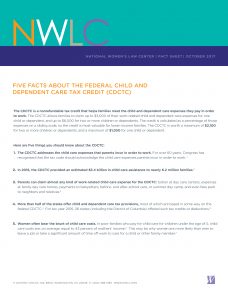Abortion rights, women of color, and LGBTQIA+ people are under attack. Pledge to join us in fighting for gender justice.

 The CDCTC is a nonrefundable tax credit that helps families meet the child and dependent care expenses they pay in order to work. The CDCTC allows families to claim up to $3,000 of their work-related child and dependent care expenses for one child or dependent, and up to $6,000 for two or more children or dependents. The credit is calculated as a percentage of those expenses on a sliding scale, so the credit is most valuable for lower-income families. The CDCTC is worth a maximum of $2,100 for two or more children or dependents, and a maximum of $1,050 for one child or dependent.
The CDCTC is a nonrefundable tax credit that helps families meet the child and dependent care expenses they pay in order to work. The CDCTC allows families to claim up to $3,000 of their work-related child and dependent care expenses for one child or dependent, and up to $6,000 for two or more children or dependents. The credit is calculated as a percentage of those expenses on a sliding scale, so the credit is most valuable for lower-income families. The CDCTC is worth a maximum of $2,100 for two or more children or dependents, and a maximum of $1,050 for one child or dependent.
Here are five things you should know about the CDCTC:
1. The CDCTC addresses the child care expenses that parents incur in order to work. For over 60 years, Congress has recognized that the tax code should acknowledge the child care expenses parents incur in order to work.
2. In 2016, the CDCTC provided an estimated $3.4 billion in child care assistance to nearly 6.2 million families.
3. Parents can claim almost any kind of work-related child care expense for the CDCTC: tuition at day care centers, expenses at family day care homes, payments to babysitters, before- and after-school care, or summer day camp, and even fees paid to neighbors and relatives.
4. More than half of the states offer child and dependent care tax provisions, most of which are based in some way on the federal CDCTC. For tax year 2016, 26 states (including the District of Columbia) offered such tax credits or deductions.
5. Women often bear the brunt of child care costs. In poor families who pay for child care for children under the age of 5, child care costs are, on average, equal to 43 percent of mothers’ income. This may be why women are more likely than men to leave a job or take a significant amount of time off work to care for a child or other family member.
